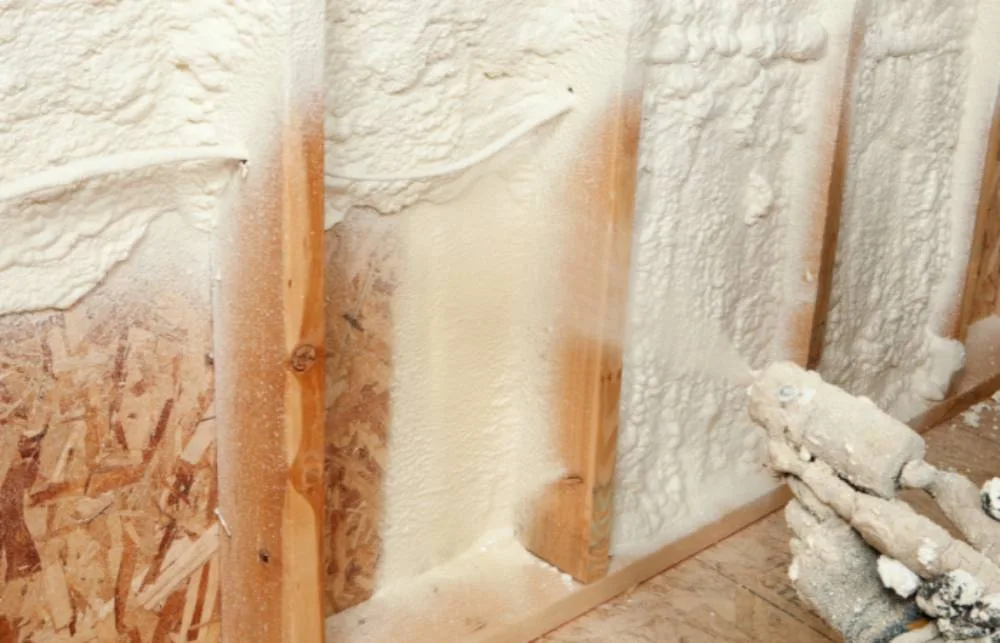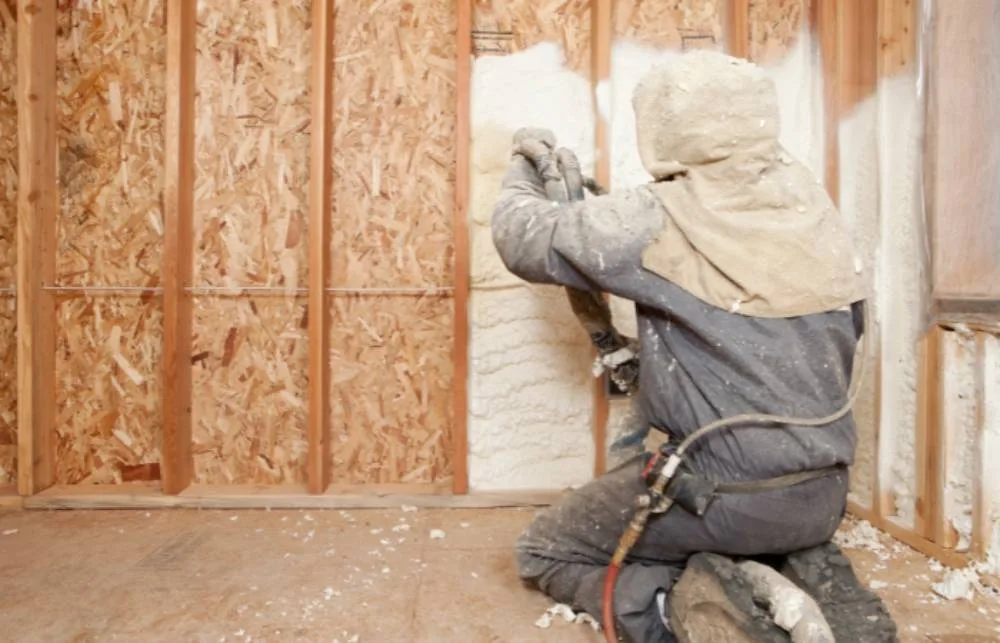Wall insulation is a crucial component of a home or building construction aimed at improving energy efficiency and maintaining comfortable indoor temperatures. It involves adding insulating materials within the walls to reduce heat transfer to keep the interior warmer in winter and cooler in summer. Common insulation materials for walls include fiberglass, cellulose, foam boards, or blown-in materials like loose-fill fiberglass or cellulose.
In this guide, we will delve into the specifics of blown-in wall insulation, exploring its functionality, various types, associated benefits, and the installation procedures involved.
What is Blown-in Wall Insulation?
Blown-in wall insulation is a method of insulating walls by injecting or blowing insulating materials into cavities, voids, or open spaces. This technique is commonly used in both new construction and retrofit projects to improve the thermal performance and energy efficiency of buildings. The insulation material is typically blown into the wall cavities using specialized equipment, allowing for effective coverage in hard-to-reach or irregular spaces.
Types of Blown-in Wall Insulation
When choosing a wall insulation material, consider factors like the desired R-value, moisture resistance, fire resistance, environmental impact, and suitability for the specific application. There are several types of blown-in wall insulation materials you can choose from:
- Fiberglass
Fiberglass blown-in insulation consists of tiny glass fibers that are blown into the wall cavities. It is a popular choice due to its cost-effectiveness and relatively high R-value (a measure of thermal resistance).
- Cellulose
Cellulose blown-in insulation is created from recycled paper or cardboard treated with fire retardants. It is an environmentally friendly option and has a good R-value. Cellulose insulation can settle over time, so proper installation is crucial.
- Mineral Wool
Mineral wool blown-in insulation is composed of rock or slag fibers. It is resistant to fire, moisture, and pests. Mineral wool insulation is known for its soundproofing capabilities and thermal insulation.
- Foam Board Particles
Some blown-in insulations use foam board particles that are broken down into small pieces. This type of insulation can offer good thermal performance and is known for effectively filling small gaps and irregular spaces.
- Polystyrene Beads
Blown-in wall insulation can also be made from expanded polystyrene (EPS) beads. These beads are lightweight and provide good thermal insulation. They are often used in retrofitting existing walls.
- Cotton
Blown-in cotton insulation is made from recycled denim or cotton fibers. It is a sustainable option and has good thermal properties. Like cellulose, cotton insulation may settle over time.
Benefits of Blown-in Wall Insulation
Blown-in wall insulation offers benefits that make it a popular choice for enhancing buildings’ energy efficiency, comfort, and overall performance. Here are some of the key benefits of blown-in wall insulation for your home or business:
- Thermal Performance
Blown-in wall insulation provides effective thermal insulation, reducing heat transfer through walls. This assists in keeping the indoor temperature comfortable and lowers the requirement for heating or cooling, resulting in energy savings.
- Energy Efficiency
By minimizing heat loss or gain, blown-in insulation contributes to increased energy efficiency in buildings. This could lead to reduced energy costs and a smaller environmental footprint by decreasing the need for heating and cooling systems.
- Versatility
Blown-in insulation is versatile and can be installed in various wall cavities like irregular shapes and hard-to-reach areas. This adaptability makes it a practical choice for both new construction and retrofit projects.
- Air Sealing
Blown-in insulation can effectively seal gaps and voids within walls that prevent air infiltration and exfiltration. This air-sealing property helps improve indoor air quality, reduces drafts, and enhances overall building comfort.
- Quick Installation
Blown-in insulation can be installed relatively quickly, especially in existing structures. This can lead to shorter construction or retrofitting timelines, minimizing disruption to occupants.
- Reduced Sound Transmission
Some blown-in insulation materials, such as cellulose and mineral wool, have good soundproofing properties. Installing blown-in insulation can help reduce noise transmission through walls, enhancing the acoustic comfort of a building.
- Environmentally Friendly Options
Many blown-in insulation materials are made from renewable materials, such as recycled paper, denim, or glass. Choosing environmentally friendly options can contribute to sustainable building practices.
- Moisture Control
Certain blown-in insulation materials, like fiberglass and mineral wool, are resistant to moisture. This helps avoid the growth of mold and mildew within wall cavities, contributing to a healthier indoor environment.
- Fire Resistance
Some blown-in insulation materials, notably mineral wool, exhibit excellent fire-resistant properties. This fire resistance can be a crucial factor in enhancing the overall fire safety of a building.
- Longevity
When properly installed, blown-in insulation can provide long-lasting performance. Proper installation is important to achieving the desired density and coverage to ensure that the insulation fills wall cavities without settling or compacting.
Installation Process for Blown-in Wall Insulation

The installation process for blown-in wall insulation can vary depending on the type of insulation material being used and the specific characteristics of the building. Here is a general overview of the installation process:
- Preparation
Before beginning the installation of blown-in wall insulation, it is crucial to prepare the walls adequately. This involves ensuring the walls are clean, dry, and free from obstructions. Identify and seal any gaps, cracks, or openings in the walls to prevent air leakage, which can compromise the effectiveness of the insulation.
- Safety Measures
Prioritize safety by using appropriate gear, including goggles, a dust mask, and gloves, especially when working with materials like cellulose or fiberglass. Additionally, turn off electrical power to outlets and switches in the areas where insulation will be installed to mitigate the risk of accidents.
- Drilling Access Holes
Access holes are strategically drilled into the walls, and the number and placement depend on the insulation material and the wall’s construction. These holes are typically drilled at the top and bottom of the walls or through the exterior siding to facilitate the blowing-in process.
- Inserting Hose and Blowing Insulation
A hose connected to the blowing equipment is inserted into the access holes, and insulation material is blown into the wall cavities using a specialized blowing machine. The machine breaks down the insulation material into smaller particles or fibers, effectively filling gaps and voids within the walls.
- Monitoring Density
Throughout the installation process, the installer monitors the density of the blown-in insulation to guarantee uniform coverage and achieve the desired R-value. Proper density control is essential for optimizing the insulation’s thermal performance.
- Sealing Access Holes
After the insulation is successfully installed, the access holes are sealed. This step involves using materials that match the wall’s finish to ensure a seamless appearance. Proper sealing helps maintain the strength of the walls and prevents air leakage.
- Clean-Up
Once the installation is complete, thorough clean-up is necessary to remove any debris or excess insulation material from the work area. Additionally, dispose of waste materials in accordance with local regulations to promote a safe and environmentally friendly process.
- Post-Installation Inspection
Conducting a post-installation inspection is essential to ensure that the blown-in insulation is evenly distributed and that there are no gaps or voids within the walls. This step confirms the overall effectiveness of the insulation and identifies any areas that may require additional attention.
Cost of Blown-in Wall Insulation
The cost of blown-in wall insulation can vary based on several factors, but it usually costs between $750 to $3,800 depending on the type of insulation and size of the space you are insulating. For a precise cost estimate for blown-in wall insulation on a particular project, it is advisable to seek quotations from insulation contractors in your local area. They can assess the project’s unique requirements and provide a detailed cost breakdown.
Blown-in Wall Insulation FAQs
What is the best insulation for interior walls?
Choosing the best insulation for interior walls depends on various factors, including the space’s specific needs, budget constraints, and personal preferences. Common options for interior wall insulation include fiberglass, mineral wool, and foam board. Each material has its advantages, such as fiberglass being cost-effective, mineral wool providing soundproofing properties, and foam board offering high R-values.
What are the side effects of blown-in insulation?
Potential side effects may include irritation to the eyes, skin, or respiratory system when working with certain materials like fiberglass or cellulose. Wearing protective gear helps reduce these risks and keeps you safe. Additionally, poor installation could result in uneven coverage or settling over time. It’s essential to hire experienced professionals to ensure proper installation and follow safety guidelines during and after installation.
Is blown-in insulation waterproof?
Blown-in insulation materials like fiberglass and mineral wool are not inherently waterproof. However, they are resistant to moisture and can still function effectively in damp conditions. It’s crucial to address any water leaks or moisture issues in the walls before installing insulation. Some insulation materials, like closed-cell spray foam, offer better moisture resistance and can act as a water barrier.
How can I insulate my walls cheaply?
Several cost-effective methods exist for insulating walls. One option is to use traditional fiberglass batts or rolls, which are relatively inexpensive and can be installed without professional assistance. Another affordable option is blown-in cellulose insulation made from recycled paper. DIY enthusiasts can often handle these projects, but consulting with insulation professionals ensures proper installation.
What thickness of insulation for walls?
The recommended thickness of insulation for walls depends on the desired level of thermal resistance, or R-value, and local building codes. Common recommendations for wall insulation range from R-13 to R-30, but these values may vary based on climate and specific energy efficiency goals. Thicker insulation generally provides higher R-values, enhancing energy efficiency.
Which type of insulation is most effective?
The effectiveness of insulation depends on factors like the insulation material, thickness, and the specific needs of the space. Closed-cell spray foam insulation is recognized for its high R-value and excellent air-sealing properties. Other materials like fiberglass, mineral wool, and cellulose can also be highly effective when properly installed.
Conclusion
Blown-in wall insulation is a practical solution for enhancing home comfort and energy efficiency. Gaps are filled by blowing materials like fiberglass, cellulose, or mineral wool into wall cavities, creating a barrier that keeps homes warmer in winter and cooler in summer. Each insulation type has its merits, from the cost-effectiveness of fiberglass to the eco-friendliness of cellulose and the fire resistance of mineral wool.
At Tropic Air Conditioning Inc., we’re your insulation experts, dedicated to ensuring your home attains the perfect balance of comfort and efficiency. To find out more about what we offer, schedule an appointment now.




